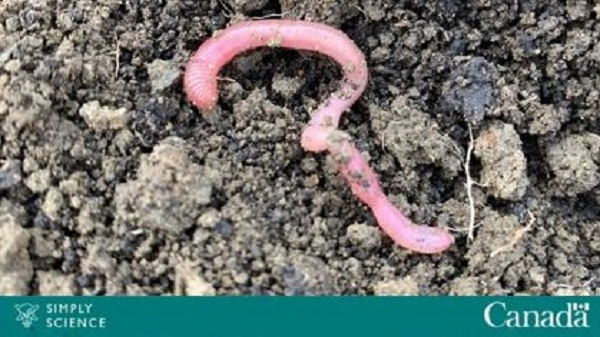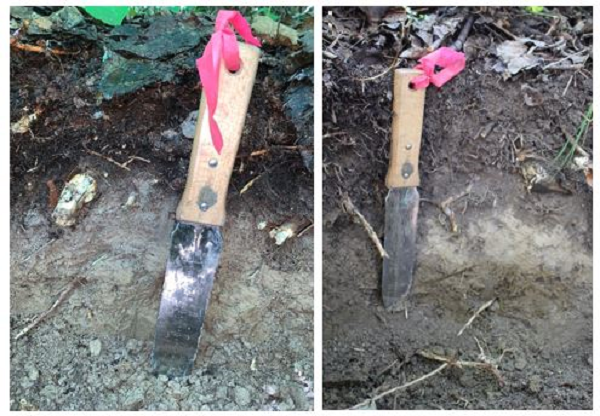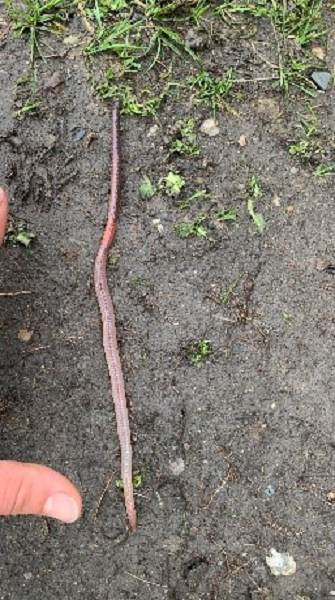Recent research suggests that the earthworms of Canada’s forests could actually be accelerating climate change.
November 2021
By Nathalie Chaperon, communications advisor — Scientific Communications Team
Some kids really love playing with earthworms, while many adults just aren’t that into them, though gardeners appreciate them and fishers rely on them. But recent scientific research tells us that these small creatures that kids find so fascinating could be a threat to Canada’s boreal forest and its essential role in the fight against climate change.

Earthworms feed on organic matter, releasing the stored carbon.
For the past 300 years, a small revolution has been taking place under our feet with the massive propagation of the modern earthworm.
“Most earthworms disappeared from North America during the last ice age more than ten thousand years ago,” explains Dr. Jérôme Laganière, a research scientist at the Laurentian Forestry Centre (LFC) of Natural Resources Canada. “They reappeared in the 18th century with the settlement of European colonists, probably transported with the soil from tomato plants.”
Jérôme is one of three authors of an important research paper recently published in Geoderma, a scientific journal specializing in soil science. The article differs from other publications on earthworms in that it advances our knowledge of their impacts on the boreal forest while previous studies have focused on the temperate forest.

On the left, a patch of soil without earthworms, you can see a thick organic layer (humus) that is distinct from the mineral soil. On the right, soil invaded by earthworms, you can see a less well-defined organic layer mixed with mineral soil.
The study
The study was conducted in 2018 and 2019 in Alberta and Quebec to compare the impact of earthworm blooms in two different soil types. In Alberta, the soils are richer and less acidic. In many regions of Quebec, on the other hand, the soils have a lower pH and are therefore more acidic, so, in theory, Quebec soils should be less hospitable to earthworms.
At least, that was the theory. But the researchers were surprised to see how abundant and active they were — even to the extent of expanding their range.
“Our study shows that earthworms are spreading north into the boreal forest,” says Jérôme. “Currently, they are present in 10 percent of the boreal forest. But by 2050, they will likely have invaded most of the boreal forest, which will have direct consequences on its ability to store carbon.”
But how do they do it?
Earthworms are voracious, attacking the organic part of the soil called humus, which is composed of moss, leaves, tree debris and other organic material. Humus can easily reach a thickness of 10 to 15 centimetres in the boreal forest. As a result, by consuming this material, earthworms are actually destroying a carbon reservoir and releasing carbon dioxide (CO2) into the atmosphere, which contributes to climate change.
And earthworm activity is significant in another aspect. Their repeated movement through the mineral part of the soil also disrupts the microbial and plant communities naturally present in the soil. Due to the relatively recent appearance of European earthworms in the boreal forest, the long-term impacts of disturbance on these communities are unknown.
But what can we do?

Tip for anglers practising their sport in the North: Take your unused bait back with you.
Clearly, we need to limit the spread of earthworms. The goal is not to destroy them but simply to prevent them from spreading in the boreal forest. We know that earthworms are useful in many other aspects — among other things, they help release nitrogen and phosphorus, two minerals needed by trees and plants.
“Earthworms are now present in northern Quebec near isolated lakes, presumably brought in by fishers,” says Jérôme. “Anglers usually leave their unused bait behind. Once released into the wild, the worms dive into the soil and disperse, and there’s no known way to stop their progress. So we need to get to the root of the problem by asking fishers to take their unused bait back with them.”
But for now, the potential problem remains: Although they seem harmless, earthworms could be accelerating climate change. And a second wave of earthworm invasion is already anticipated, this time from Asia, with larger, more voracious earthworms that are even more active — they’re even earned the nickname “jumping worms.”
Yet this recent research allows us to start taking action now. A simple gesture by Canadian fishers would help reduce the threat to the boreal forest and thus contribute to the fight against climate change.
The study was conducted by doctoral student Justine Lejoly, supervised by Professor Sylvie Quideau, both of the University of Alberta, with the collaboration of research scientist Jérôme Laganière of Natural Resources Canada. The full article appears in Geoderma.
For more information:
Explore:
More about Jérôme Laganière’s work on ResearchGate
8 facts about Canada’s boreal forest
World Earthworm Day
Geoderma article: Invasive earthworms affect soil morphological features
Watch:
Canada’s Boreal Forest